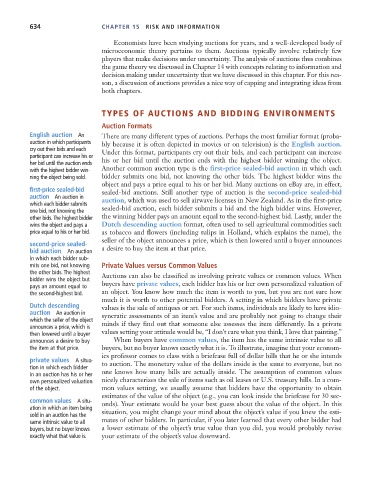Page 660 - Microeconomics, Fourth Edition
P. 660
c15riskandinformation.qxd 8/16/10 11:10 AM Page 634
634 CHAPTER 15 RISK AND INFORMATION
Economists have been studying auctions for years, and a well-developed body of
microeconomic theory pertains to them. Auctions typically involve relatively few
players that make decisions under uncertainty. The analysis of auctions thus combines
the game theory we discussed in Chapter 14 with concepts relating to information and
decision making under uncertainty that we have discussed in this chapter. For this rea-
son, a discussion of auctions provides a nice way of capping and integrating ideas from
both chapters.
TYPES OF AUCTIONS AND BIDDING ENVIRONMENTS
Auction Formats
English auction An There are many different types of auctions. Perhaps the most familiar format (proba-
auction in which participants bly because it is often depicted in movies or on television) is the English auction.
cry out their bids and each Under this format, participants cry out their bids, and each participant can increase
participant can increase his or his or her bid until the auction ends with the highest bidder winning the object.
her bid until the auction ends
with the highest bidder win- Another common auction type is the first-price sealed-bid auction in which each
ning the object being sold. bidder submits one bid, not knowing the other bids. The highest bidder wins the
object and pays a price equal to his or her bid. Many auctions on eBay are, in effect,
first-price sealed-bid sealed-bid auctions. Still another type of auction is the second-price sealed-bid
auction An auction in auction, which was used to sell airwave licenses in New Zealand. As in the first-price
which each bidder submits
one bid, not knowing the sealed-bid auction, each bidder submits a bid and the high bidder wins. However,
other bids.The highest bidder the winning bidder pays an amount equal to the second-highest bid. Lastly, under the
wins the object and pays a Dutch descending auction format, often used to sell agricultural commodities such
price equal to his or her bid. as tobacco and flowers (including tulips in Holland, which explains the name), the
seller of the object announces a price, which is then lowered until a buyer announces
second-price sealed-
bid auction An auction a desire to buy the item at that price.
in which each bidder sub-
mits one bid, not knowing Private Values versus Common Values
the other bids. The highest Auctions can also be classified as involving private values or common values. When
bidder wins the object but
pays an amount equal to buyers have private values, each bidder has his or her own personalized valuation of
the second-highest bid. an object. You know how much the item is worth to you, but you are not sure how
much it is worth to other potential bidders. A setting in which bidders have private
Dutch descending values is the sale of antiques or art. For such items, individuals are likely to have idio-
auction An auction in syncratic assessments of an item’s value and are probably not going to change their
which the seller of the object minds if they find out that someone else assesses the item differently. In a private
announces a price, which is
then lowered until a buyer values setting your attitude would be, “I don’t care what you think, I love that painting.”
announces a desire to buy When buyers have common values, the item has the same intrinsic value to all
the item at that price. buyers, but no buyer knows exactly what it is. To illustrate, imagine that your econom-
ics professor comes to class with a briefcase full of dollar bills that he or she intends
private values A situa- to auction. The monetary value of the dollars inside is the same to everyone, but no
tion in which each bidder
in an auction has his or her one knows how many bills are actually inside. The assumption of common values
own personalized valuation nicely characterizes the sale of items such as oil leases or U.S. treasury bills. In a com-
of the object. mon values setting, we usually assume that bidders have the opportunity to obtain
estimates of the value of the object (e.g., you can look inside the briefcase for 30 sec-
common values A situ- onds). Your estimate would be your best guess about the value of the object. In this
ation in which an item being situation, you might change your mind about the object’s value if you knew the esti-
sold in an auction has the
same intrinsic value to all mates of other bidders. In particular, if you later learned that every other bidder had
buyers, but no buyer knows a lower estimate of the object’s true value than you did, you would probably revise
exactly what that value is. your estimate of the object’s value downward.

